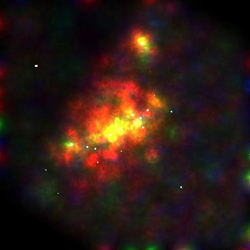May 27, 2003
MSFC Press Release
RELEASE: 03-080
Using the NASA Chandra X-ray Observatory for the most comprehensive survey of X-ray sources in nearby galaxies, NASA scientists have shown that the brightest of these objects are otherwise indistinguishable from stellar-mass black holes and neutron stars. This result complicates the ongoing hunt for an emerging but elusive class of intermediate-mass black holes - objects whose existence would defy conventional black-hole formation theory.
The scientists surveyed over 3500 X-ray sources in 90 nearby galaxies (other than the Milky Way). Among these sources, the NASA team identified 120 unusually bright ones, categorized as Ultra-Luminous X-ray sources (ULXs) - candidates for intermediate-mass black holes. The team found that, apart from brightness, the ULX class shared many of the more fundamental X-ray properties of the dimmer neutron stars and stellar-mass black holes.
"Statistically, it looks like many ULXs may be just extreme cases of rather typical X-ray objects," said Dr. Douglas Swartz of the National Space Science & Technology Center at NASA's Marshall Space Flight Center in Huntsville, Ala., who led the analysis. Among proposed explanations for a ULX is an intermediate-mass black hole. If ULXs are intermediate-mass black holes, they must have properties similar to those of neutron stars and stellar-mass black holes.
Another proposed explanation for an ULX is a micro-blazar - a stellar-mass black hole whose radiation happens to be beamed in the direction of the Earth. "Beaming" occurs when an object emits electromagnetic radiation (such as X rays) into a preferred direction rather than equally in all directions, much like a lighthouse beacon. If the Earth happens to lie in this direction, then an X-ray source will appear very bright or luminous. Because of beaming, Swartz said, a stellar-mass black hole could appear ultra-luminous.
Swartz and colleagues, Dr. Kajal Ghosh and Dr. Allyn Tennant, both of the NSSTC at Marshall, compared the X-ray characteristics of the ULXs with those of the other X-ray sources. These characteristics included the change in brightness over time, the X-ray frequency (X-ray "colors"), and the spatial distribution of the sources within their host galaxies. Swartz and his colleagues found that the X-ray properties of the 120 ULXs looked rather similar to those of the larger population. It was this that led to their conclusion that the ULXs differed from their sub-ULX counterparts only in apparent luminosity, or degree of brightness.
"Some of the sources we've analyzed have characteristics of intermediate-mass black holes, others have characteristics of beamed sources (such as micro-blazars) or of supernovas," Swartz said. "But the reality is that most of the ULX sources just look like brighter versions of the other detected sources."
Nevertheless, he cautioned that these findings don't contradict other recent studies linking individual ULXs to intermediate-mass black holes or micro-blazars. "We are analyzing the ULX class as a whole. Our approach complements research by other groups that scrutinize individual ULXs both in X rays and at other wavelengths. Both approaches are important and together we should soon reach a fuller understanding of these exotic objects," Swartz said. The team hopes to carry out future surveys with longer observation times and a larger sample of galaxies to understand the objects more fully.
NASA's Marshall Space Flight Center manages the Chandra program, and Northrop Grumman Space Technology (NGST), Redondo Beach, Calif., is the prime contractor for the spacecraft. The Smithsonian's Chandra X-ray Center controls science and flight operations from Cambridge, Mass., for the Office of Space Science at NASA Headquarters, Washington.
For more information, refer to
MEDIA CONTACTS
Steve Roy
Marshall Space Flight Center, Huntsville, AL
Phone: 256-544-6535



